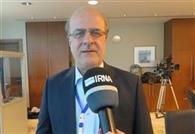
Dr. Mohammad Pourkazemi interviewed by IRNA in Baku
Description: The director of the Iranian Fisheries Science and Research Institute mentioned that the only way out of reducing the reserves of aquatic organisms in the Caspian Sea and saving the ecosystem of this sea is the joint action of the five coastal countries of the Caspian Sea
Text: Dr. Mohammad Pourkazemi, who traveled to Baku for participation in the International Conference on Sustainable Aquaculture in the Caspian Sea, said in an interview with IRNA on Thursday, "To implement a joint operational program between the five countries of Iran, Russia, Azerbaijan, Turkmenistan and Kazakhstan, the capacity of the Food and Agriculture Organization of the United Nations (FAO) can be used as a mediator to prevent the deterioration of the reserves of this sea. He added: "The main goal of today's conference is to preserve the reserves of aquatic organisms in the Caspian Sea, especially the joint reserves of the five coastal countries of the sea. Important issues were also presented about the endangered species of Kilka, bony fish and sturgeon. Dr. Pourkazemi added: "The most important discussion that followed today at the conference was that with regard to the reduction of the reserves of aquatic organisms was that on the one hand, how and with what measures can maintain the reserves of aquatic organisms in the Caspian Sea and have sustained exploitation, on the other hand with the development of sustainable aquaculture, how and with what measures can provide jobs and produce protein and at the same time cope with unauthorized fisheries. In response to the question of what is the solution to the goals set at this conference, he said: Using the experiences of the five coastal countries of the Caspian Sea and implementing the approvals of the Commissions of live resources of the Caspian Sea can save the Caspian Sea from this situation. The director of the Iranian Fisheries Science and Research Institute said about the latest status of the Caspian Sea: The reports presented by the various countries at the conference showed that the status of the Caspian Sea is different on the coasts of the five coastal countries. Dr. Pourkazemi added: "Fortunately, we have a better situation in Iran, for example, Kilka fish stocks have been reduced in other countries including Russia, Kazakhstan and Azerbaijan". Referring to the increased fishing of Kilka in Iran, he said, "This relates to the type of management, reducing the number of marine vessels and the costs that the government has spent on purchasing fishing licenses for marine vessels along with the research that the institute has conducted to estimate the reserves". He added: Despite the entry of the warty comb jelly to the Caspian Sea, the Islamic Republic of Iran has managed to catch over 20,000 tons of Kilka, although the catch composition of Kilka has changed and the reserves ofClupeonella cultriventris have increased. Dr. Pourkazemi added: "In addition to the five endangered species of sturgeon, many other species such as the Caspian salmon, barbs, and asp are also under the threat of extinction which was also discussed at the conference". He added that the countries participating in the conference were also looking at how we can prevent the extinction of these fish through aquaculture by creating a gene bank and private sector partnerships. About the position of the Convention on the legal status of the Caspian Sea regarding the conservation of the reserves of aquatic organisms, he said: "In the Convention on the legal status of the Caspian Sea, fisheries and fishing have been delegated to the commission for living resources. Dr. Pourkazemi mentioned that the Caspian Sea is not the only sea whose reserves have decreased and its species are under the threat of extinction, these problems have occurred in many seas and ecosystems and some countries have been confronted with these problems by planning and using the experiences of other countries, especially the experiences of FAO and knowledge of researchers.
Monday 19 Nov 2018
Author: Public relations of the Iranian Fisheries Science and Research Institute
Visit Count:474